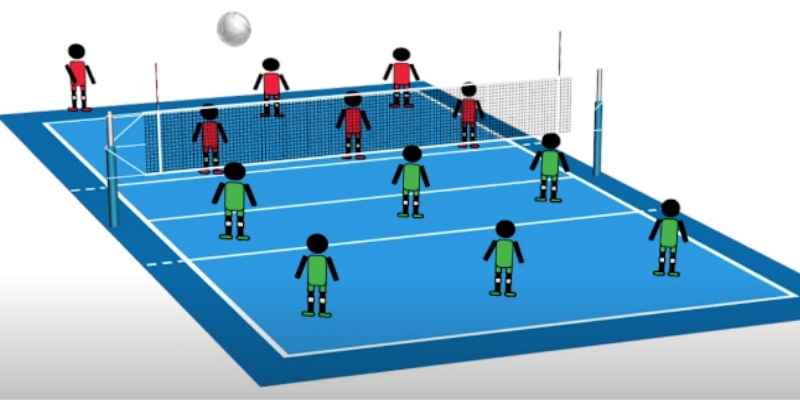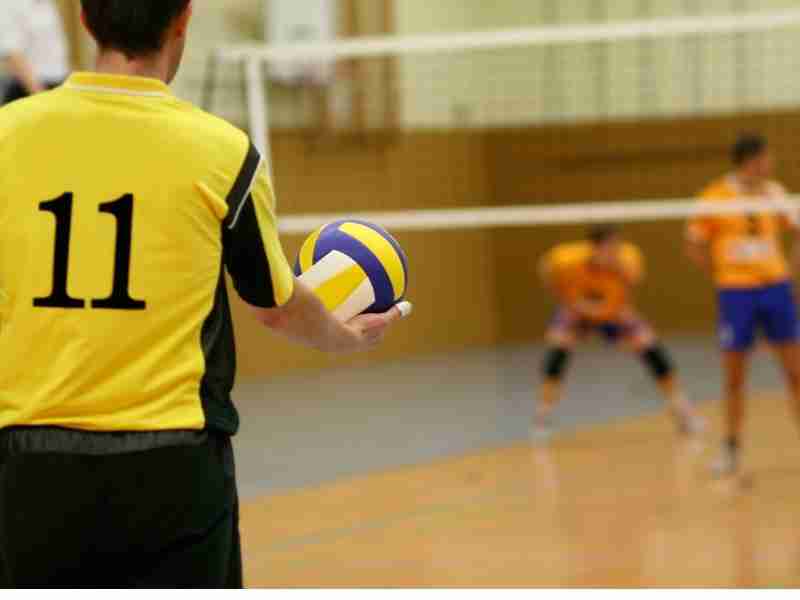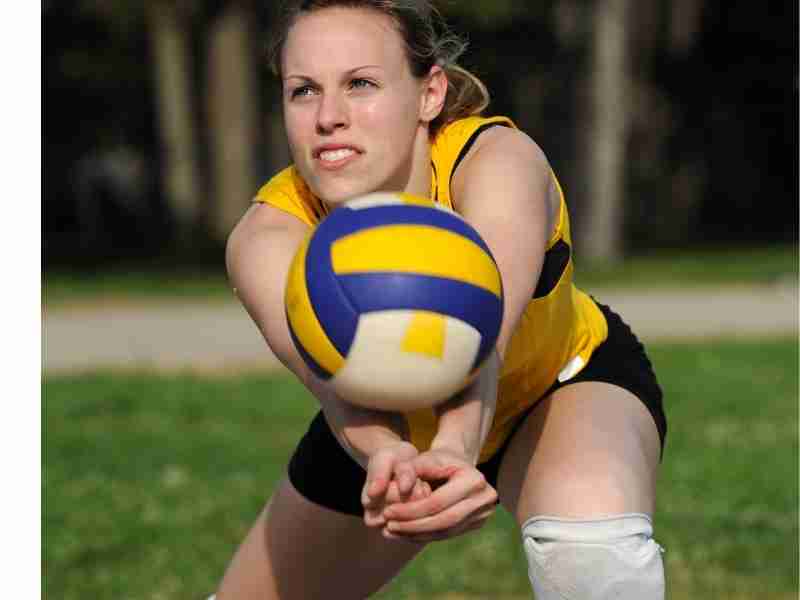
Have you ever wondered how to play volleyball? This fun and engaging sport can be a great way to get in shape and have some fun.
It is one of the few sports requiring physical and mental strength. It would be best if you had good hand-eye coordination to spike the ball over the net, but you also need to think quickly on your feet and make strategic decisions. It would be best if you had a strong work ethic and were determined to improve your skills.
In this post, we’ll look at the basics of playing volleyball. We’ll also discuss some key skills you need to play this game well. So whether you’re new to volleyball or looking to improve your game, keep reading for some helpful tips!
Volleyball Basics
There are six players on an indoor volleyball team, but beach volleyball is played with two people. The front row players are usually known as the “frontcourt.” They are responsible for attacking the ball and keeping it off the ground.
The back-row players are responsible for blocking the ball and preventing it from hitting the ground. They are also responsible for receiving the ball from the other team and setting it up for the frontcourt players to attack.
Players can move anywhere around the court, but there are certain positions that they are responsible for. The setter is usually responsible for putting the ball into play. The hitter is responsible for attacking the ball and trying to score points. The blocker is responsible for blocking the ball and preventing the other team from scoring points.
Volleyball is a game of quick movements and reactions. Players need to be able to jump, dive and hit the ball to be successful.
There are a few basic rules that all players need to know to play volleyball. The first rule is that the ball can only be touched with the hands or arms. The second rule is that the ball must be hit over the net and into the other team’s court, and the third rule is that the ball can only bounce once on each side of the court.
Players can score points in several ways. The most common way to score points is by serving the ball into the other team’s court and having them fail to return it. Players can also score points by spiking the ball over the net and into the other team’s court. The third way to score points is by setting the ball up for another player to spike it.
Each team tries to get points by hitting the ball over the net and into the other team’s court. If the ball touches the ground in your court or hits it out of bounds, your team will lose the point. The game goes to 25 points, with a difference of two points. If the teams are too close, the game can go on longer than 25 points.
In the last deciding game of the match, it’s only played to 15 points, but the difference of two points still counts. In beach volleyball, a game lasts until 21 points are scored; the same rule applies to the last round and the tiebreaker.
Additionally, you can score a point if the opposing team’s shot leaves the marked court boundary. It’s also possible for your team to achieve if a player on the opposing team makes a mistake.
You have to hit the ball over the net and into the other team’s court when you serve. The ball is then passed back to the other team. If they can’t get the ball back, or it goes out of the court, the team that served gets the point. Most games are played to 21 points, and only the team serving can score points.
Also, teams must switch places around the court in a clockwise direction when playing volleyball after scoring a point. Before sending the ball back to the other side of the court, they can only hit the ball to each team member three times.
Positions In Volleyball
In volleyball, each team has six players on the court simultaneously. Three players are in the front row and three are in the back row. The front row is responsible for attacking the ball, while the back row is responsible for defending the net.
Here are the positions in volleyball and what they entail:
1. Setter – Sets up the attacks for the other players and directs the offense. Setters are like quarterbacks; they are often in the back of the court and can work in both rows.
2. Outside hitter – The outside hitter is a player standing in the front left of the court. They are often called the wing spiker. They attack the ball when it is set for them. While the ball is in play, they can move across the front and back rows.
3. Middle hitter – Hits balls that come down the court’s middle. The middle blocker is right in front of the net. Their primary responsibility is to block the ball from the other team. They are also vital passer who helps get the ball to the setter.
4. Libero – A defensive specialist who can only play back row; usually covers for missed shots or makes saves off of spikes.
5. Opposite Hitter -This player scores the most points in the game. They usually play in the back left corner of the court. They need to score points but also defensive skills to play against the other team’s opposite hitter.
6. Right-side hitter – The right-side hitter has responsibilities similar to those of the outside hitter, but they focus on the right side of the court.
Volleyball Points
When playing volleyball, the team that wins each rally scores a point. To win a rally, your team must serve the ball over the net into your opponent’s court.
There are two ways to score points in a rally. Your team can score after you serve or the other team’s serve.
Some volleyball courts still use the term side out. This means that the other team gets to serve again when your team scores a point. The player must stand behind the backline and hit the ball over the net between the antennas.
Rotation In Volleyball
In volleyball, players rotate on the court after each side-out. This means that a new player goes to serve after each side-out. This rotation ensures that all players get a chance to play and serve.
Rotation in volleyball is a strategic move where players shift positions on the court to create favorable matchups and open up attacking opportunities.
Many rotation schemes can be used, but the most common ones involve 6, 5, 4, or 3 players. Rotation can be a complex process, but it is an integral part of the game. When used correctly, rotation can be a powerful tool for winning volleyball games.
Players can take advantage of their opponent’s weaknesses and score points by creating mismatches and open spaces.
Volleyball Skills
Serve
It is essential to start with an overhead serve when teaching beginning volleyball players. This serves two purposes. First, it is easier for the server. Second, it allows longer rallies in practice. The overhead serve can make serving and play very difficult for the beginning volleyball players. The purpose of the serve is to give a hard time to the opponent’s offense, but teaching beginning volleyball players is not the best practice.
Instead, focus on teaching them the proper form and how to control the ball. With time and practice, they can develop a more effective serving style for gameplay.
Catch and Toss
Catching and tossing in volleyball is essential for beginners to keep the ball up. Players should use their hands together when catching and make a cupping motion. They should then quickly transfer the ball to their tossing hand and release it upwards.
Tossing players should use their whole arm to toss the ball, keeping their hands open and fingers together. The ball should be released about halfway between their waist and head. Players should then use their non-tossing arms to help guide the ball into the air.
Players should keep the ball in the air for as long as possible to improve their skills. It is also vital to ensure that players use three contacts when playing volleyball. The first contact should be made with the ball in front of the player’s body.
The second contact should be made with the ball at the player’s waist. The third and final contact should be made with the ball above the player’s head. This will ensure that players use proper technique and not just rely on their arms to hit the ball.
Volleyball Passing
Volleyball passing is an essential skill that every player needs to know. There are three basic types of passes: the bump, the set, and the spike.
The bump pass is the most common type of pass. It is used when you want to keep the ball low and away from the opponent. You hold the ball in your hands and bump it to your teammate to do a bump pass.
The set pass is used when you want to set the ball up for a spike. You hold the ball in your hands and set it to your teammate to do a set pass.
The spike pass is used when you want to hit the ball hard and fast. To do a spike pass, you hold the ball in your hands and spike it to your teammate.
Bumping or Overhead
Players will often use an underhand serve to generate more power and control when serving. To do this, the player stands at the back of the court and tosses the ball into the air. They then strike it with their hand, arm extended, and direct it over the net into their opponent’s court.
Players can also choose to serve overhead. To do this, the player stands at the back of the court and tosses the ball into the air. They then strike it with their hand, arm extended, and direct it over the net into their opponent’s court.
When receiving a serve, the player usually tries to bump the ball with their forearm to return it. To do this, they extend their arm and make contact with the ball, redirecting it back over the net.
If the player cannot return the ball using a bump, they may instead choose to set it. To do this, they extend their arms overhead and direct the ball towards their teammate, who will then try to spike it.
Lastly, if the player is in a good position, they may instead choose to spike the ball. To do this, they extend their arm and direct the ball downwards into their opponent’s court.
Passers / Serve Receivers
Three types of volleyball players are hitters, blockers, and passers. The passer is someone who specializes in receiving the serve and passing it to another player. They are also responsible for defensive plays such as digging balls that come their way. Usually, the outside hitters and right side hitters carry the passing/serve and receive responsibility.
The term “libero” is used to describe a player who specializes in defensive plays. They are responsible for digging balls and passing them to the hitters.
In some cases, the libero may also be responsible for setting the ball. The libero must wear a different color jersey so that the officials and their teammates can quickly identify them.
The hitters, also known as the spikers, are responsible for attacking the ball and trying to score points. They usually stand at the front of the court and try to hit the ball over the net into the opposing team’s court.
The blockers are responsible for blocking the hitter’s spikes. They stand at the net and try to stop the ball from going over into their court.
Therefore, the passer must pass the ball accurately to the hitters, who then need to spike the ball over the net. The blockers need to sync with the hitters to block the spikes. And finally, the libero needs to be quick and agile to dig the ball and keep it in play.
Volleyball Setting
This is an essential skill in volleyball and can help your team score points. The setting motion is a little different than the serving motion.
The setter is the player who controls the ball after another player has hit it, and they are responsible for getting the ball to their hitters in a position where they can score.
The set is used to start the offensive play of the team. A bump or a hand pass gets the ball into the air, and the setter is in charge of getting the ball to their hitters in an excellent position to score. A setter needs to have good hand-eye coordination, as well as good placement skills.
When setting the ball, the player must keep their arms fully extended and make sure that the ball makes contact with their hands at the base of their fingers. The player should snap their wrists to send the ball over the net. It is vital to keep the ball low, as this will make it more difficult for the opposing team to return.
When setting the ball with fingers, the player places one hand above their head and the other hand above their forehead.
To play this game, you need to hold your hands like this: your index fingers and thumbs should form a triangle and be 1-2 inches away from each other. You should then contact the ball with your fingers without letting it touch the bottom of your hands. By doing this, it allows for a more precise and controlled setting of the ball.
Volleyball Spiking / Attacking
The above heading refers to spiking or attacking the ball in volleyball. To spike the ball, you must first jump up and then hit the ball with your arm. You will want to aim for the top of the ball to go over the net and into your opponent’s court.
How Do You Spike a Volleyball?
To spike in volleyball, you must approach the ball quickly and jump high. You can do this by taking a four-step approach (First, take a right step, then a left step to get speed). Then place your feet, right and left, on the ground for jumping.
Make sure you jump off of both feet at the same time and land on both feet as well. Another way to approach the ball is by taking a three-step approach (First, taking a left step for speed). Then place your feet, right and left, on the ground for jumping. When you jump, extend your arms above your head and hit the ball with the palm of your hand.
Hit the ball hard, so it goes over the net and into your opponents’ court. If you cannot hit the ball over the net, it is considered a “fault,” and your opponent will get the point. Faults include: touching the net, stepping on or over the line, hitting the ball out of bounds, or not hitting the ball over the net. There are also “invasion” faults, which occur when a player steps into the opponent’s court before hitting the ball. If you commit any of these faults, your opponent will automatically receive the point.
Further, when spiking in volleyball, ensure you are close to the net. You also want to make sure you jump high and spike the ball with your arm straight. Also, follow through with your spike and land on two feet.
Arm Swing to Lift You Up
To play volleyball effectively, you need to jump high and have a mighty arm swing. You can improve your jumping ability by doing exercises focusing on your calf and thigh muscles.
A good way to increase your arm swing is to practice without a ball, making sure that your feet and arms are working in sync. Once you have the basic skills, you can start practicing with a ball.
Timing
When spiking a volleyball, it is crucial to time your jump correctly. You want to ensure you are jumping at the right time to reach the ball and spike it with enough force to make it past the opposing team’s blockers. There are a few things to keep in mind when timing your jump.
The first is to make sure you jump off of the correct foot. You will want to jump off your right foot if you are a right-handed spiker. You will want to jump off your left foot if you are left-handed.
The second thing to remember is the timing of your jump relative to the setter releasing the ball. You want to ensure you are jumping at the right time to reach the ball and spike it with enough force to make it past the opposing team’s blockers.
How Does a Volleyball Block Work?
When you are in the defensive position and see that the opponent will hit the ball, you need to jump up into the air slightly and then push your hands over the net.
Reach into the other side of the net and towards the attacker. You will use your hands and arms to try to block the ball. If you are successful, the ball will go back to your side of the net, and your team will gain possession. If you are unsuccessful, the ball will go through the net, and your opponent will score a point.
Volleyball blocking is a significant part of the game and can be the difference between winning and losing. It is a defensive move that can stop the opponent’s attack and give your team the upper hand. You will be an invaluable asset to your team if you can learn how to execute a volleyball block properly.
Volleyball Blocking Basic Rules
Volleyball blocking is an integral part of the game. There are specific rules that must be followed when blocking.
First, only three players from the front row are allowed to block the ball. These players must be standing in front of the net and cannot cross over to the other side of the court.
Second, a blocker can only reach over the net to stop the ball after the opponent’s third contact. If the opponents have already hit the ball twice, the blocker can try to block it.
Third, when the ball is in the plane of the net (when any part of the ball is above the net), both sides have the right to play the ball. However, even by half an inch, both sides can play the ball when the ball crosses the net.
How to Play Digging in Volleyball?
When playing defense in volleyball, one of the essential skills to learn is digging. Digging is the act of preventing the ball from falling into the court after the opponent’s attack. There are two ways to dig the ball: underhanded and overhead.
Underhanded digging is done by bumping the ball with your palm, which is the most common way to dig. Overhead digging is done by reaching up with your fingers and slapping the ball away from the court.
Most of the digging is done by three players in the back row. But if the player in the front row doesn’t block, it’s his job to help the players in the backcourt defend. The defensive players and blockers strictly follow the team’s defensive strategy (i.e., do they block the line, or angle shots).
Some tips for digging:
– Get low: When you dig, you want to be in a low stance so that you can quickly move in any direction.
– Keep your arms straight: This will help you generate more power when you contact the ball.
How to Play Cover in Volleyball
One of the key strategies when playing defense in volleyball is to cover. This means positioning oneself under the block to save the ball back into play if the blocker manages to block the hitter.
In addition, if there is an opportunity, the spiker may also make an intended swing to the block and use the block to rebound the ball back to their courtside.
Of course, for this strategy to be effective, the spiker needs teammates on the coverage to dig the ball for the setter. Without good coverage, defending against an opposing team’s attack is difficult.
Therefore, all players on the court must be aware of their positioning and prepared to cover when necessary. A team can significantly improve their chances of winning a volleyball match with proper coverage.
Volleyball Basic Tips
Some tips can help make the game more enjoyable and even give you an edge over your opponents.
Wear The Proper Attire
Volleyball is typically played on a hardwood court; however, it can also be played on sand or grass. To play volleyball, you will need some essential gear. This includes indoor shoes that are non-marking so as not to damage the court, knee pads (optional) and gym clothes that fit well. Volleyball is a sport that requires a lot of jumping and diving, so it is important to have clothing that won’t get in your way.
A good pair of indoor shoes is one of the essential pieces of gear for volleyball. These shoes should be non-marking so as not to damage the court. They should also provide good traction and support to prevent injuries. Knee pads are optional but can give new players more confidence when diving for a ball.
Volleyball is a sport that requires a lot of movement, so it is essential to wear clothing that won’t get in your way. Baggy clothes can be a hazard as they can get caught on the net or by other players. Fitted clothes are a better option as they allow you to move more freely.
Warm Up Before the Game Begins
A good warmup prepares your muscles and joints to work harder during the following physical activity. Volleyball requires a lot of jumping, so it’s essential to take the time to warm up before the game. Among the things you can do to get warm are:
-Jogging in place for a few minutes
-Doing some light stretching
-Jumping Jacks
Warming up before playing will help you avoid injury and perform at your best. So take the time to do it right!
Attempt To Use All Three Hits
To play volleyball using the three-hit strategy, you must understand each player’s role on the court. The hitter is responsible for slamming the ball down onto the other team’s side of the court, while the setter is responsible for setting up the hitter with a well-placed ball. The third player in this strategy is the blocker, who helps to defend the hitter and keep the ball from being sent back over the net.
When executing a three-hit play, the hitter will start by bumping the ball up to the setter. The setter will then place the ball into position for the hitter to spike it down onto the other team’s side of the court. The blocker will be positioned at the net to defend against any attempts by the other team to send the ball back over.
If all three players execute their roles correctly, the ball should travel from the setter to the hitter and then down onto the other team’s side of the court, resulting in a point. This play can be very effective when executed correctly, but it requires all three players to be on the same page and working together.
Set The Ball Away From The Net
Setting the ball too close to the net can make it difficult for the hitter to make a play. When setting, aim for about a foot away from the net so that the ball has a better chance of getting over. Don’t expect the setter to be able to place the ball perfectly, mainly if they are not used to the setting. The hitter should be prepared to adjust their approach accordingly.
Aim for about a foot away from the net. This will give the hitter more time to react and hit the ball and make it more difficult for the other team to block. The hitter shouldn’t expect a perfect set from a non-setter player, so they should be ready to adjust.
During A Play, Don’t Catch The Ball
The players will figure it out, or the ref will blow their whistle again, and the play will end for real. In volleyball, the play is only considered active until the ball hits the ground. That means if you catch the ball before it hits the ground, the play is still active, and you can keep playing. However, if you catch the ball after it hits the ground, the play is over, and you cannot keep playing.
This can be unclear because in other sports like basketball or football, the play is considered over when the ball is caught.
This rule exists in volleyball to keep the game moving and prevent players from stalling. So if you catch the ball during a play, keep playing until the whistle is blown!
Serve Without Foot Violations
A critical aspect of playing volleyball is avoiding foot violations. When serving the ball, ensure your feet are behind the end line. If you step over the line, it is a foot violation, and the other team will get the point.
FAQs
What Are Illegal Hits In Volleyball?
There are five ways to move the ball in volleyball legally. You can slap it, bump it with two hands, carry it, palm it, or direct it.
Can I Use My Head In Volleyball?
You can use any part of your body to play the ball in volleyball including head, as long as the action you take is correct.
What Are Points Called In Volleyball?
In volleyball, the team that wins a rally gets the point. When the other team wins a rally, they get one point and the right to serve. The players on the other team rotate one position clockwise.
What Are The Positions In Volleyball?
- Setter.
- Outside Hitter.
- Opposite Hitter.
- Middle Blocker.
- Libero.
- Right side hitter
How Does A Volleyball Game End?
The team who wins the most games (3 games) is the overall winner of the match. The first team to win 3 games of beach volleyball is the winner. To win a game, a team must score 25 points with a 2-point difference. If they are too closely matched, the game can continue over the 25-point.
What is Yellow Card in Volleyball?
A yellow card in volleyball is used to indicate a warning to a player. It is usually given for unsportsmanlike conduct or if a player exhibits violent behavior. Receiving two yellow cards in the same game results in an automatic red card and expulsion from the match.
Final Thoughts
To play a successful game of volleyball, you must know the basics. This includes understanding the positions on the court and how to get the point. With a bit of practice, you can play like a pro in no time!






